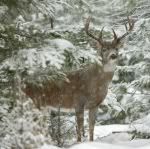 The deer hunting season is fast coming to an end. If you have still not tagged out, now may be your last chance to connect with a buck. Despite popular belief the late season might yet be the best time of the year to fulfill your dream of getting a wall hanger.
The deer hunting season is fast coming to an end. If you have still not tagged out, now may be your last chance to connect with a buck. Despite popular belief the late season might yet be the best time of the year to fulfill your dream of getting a wall hanger.Hunting a trophy buck is very tough. In the early season deer have plentiful food available and the cover is thick. Under these conditions it is very hard to predict when and where a buck will be; there is just so much food for the deer to choose from.
Then comes the rut. During this time the bucks travel great distances in search of receptive does. At this time a buck can be anywhere, here today gone tomorrow and there is no way to tell where he will turn up next. In addition, the hunting season is in full swing, the woods are full of hunters and the bucks have turned nocturnal making it even more difficult.
But then comes the winter. It’s cold and often there is snow on the ground. Everything changes now. The buck hasn’t eaten much during the rut and may have lost as much as 25% to 30% of his body weight. His sole priority now is to gain all that lost weight back, but there is not much food left for him. In order to regain his weight and make it through the often harsh winter he retreats to a small core area where there is still good cover, shelter and food is close by.
The bucks will do only two things – eat and sleep. To eat as much as he can the buck has to abandon his nocturnal travel pattern and feed all day long between taking naps. This fact plus the fact that the hunter actually can see now for a long ways in the woods makes the bucks vulnerable. But don’t be fooled into believing that it will be easy pickings. Hunting a big mature buck is never easy, but in the late season a hunter has a much better chance of filling his tag than perhaps at any other time during the hunting season. So don’t hang your bow or muzzleloader up yet. Brave the cold and the snow and get out into the woods. The hunting season is not over until it says so in your state or provincial hunting regulations.
I leave you here with a few late season hunting tips that have worked well for me and will do the same for you.
Scouting:
In order to find the buck’s hideout you have got to scout first. Deer seek out the thick stuff; such as young pine growth, cedar or hemlock when possible but also small woodlots with thick undergrowth, overgrown hedgerows and patches of high grass. These structures give the deer a measure of security but also shelter from the harsh elements.
Food:
In the late winter bucks often re-visit harvested agricultural fields where they look for the last morsels of nutritious food. Look under oak trees for acorns that are left over from the fall. Find these few remaining food sources with bedding areas nearby and you’re in business.
Time to hunt:
In the winter when the weather is below freezing, the deer travel later in the morning and earlier in the evening. Most deer movement will be in the morning around 8:00 am and then again around 3:00pm. In very cold weather you will see deer movement all day long with the peak around midday when it is warmer than at other times of the day. Prepare to hunt all day long.
Deer like it warm:
In order to conserve energy and stay warm deer seek the sunny and wind sheltered hillsides where they doze and lounge in the warmth of the sun.
Track’em down:
If there is a fresh layer of snow from the previous night you can track a buck in the snow right to his hideout.
The wind:
Watch the wind and air currents. Deer are still very spooky and will not tolerate any human scent. Hunt in a good crosswind or still better with the wind in your face. Thermals rise uphill in the morning as the air warms up and descend downhill in the afternoon as the air cools off. Bear that in mind when you are in hilly areas and hunt accordingly.
Scent, Calls and Rattling:
Depending on the buck to doe ratio, the late season could still see some minor rut activity. Using scent judiciously can work to bring a buck out of his bed; so can calling and rattling. However, at this time of year the bucks are worn out so keep your calling and rattling friendly and brief.
Treestand or Ground?
It’s really way to cold to sit all day long in a treestand. No matter how many layers you wear after one or two hours of sitting motionless in a treestand you will be very cold. It is better to hunt several stands and then, still-hunt from one location to the next along known deer holding areas. Hunt from a stand only during the peak moving times for about one hour then move to the next stand location. Look for a good sized tree to hang your stand on – one that gives you good background cover since there are no leaves left on the trees. Personally I avoid hunting from treestands in the winter and instead stay on the ground using trees, deadfalls and other structures as natural groundblinds.

No comments:
Post a Comment